Whenever I see a kingfish head at the fish market, I get the urge to buy it and cook Grilled Kingfish Head (Kingfish Kabutoyaki). The flesh you get from the head and collar is so tasty and the cost of 1 head is low considering the amount of meat you can get.
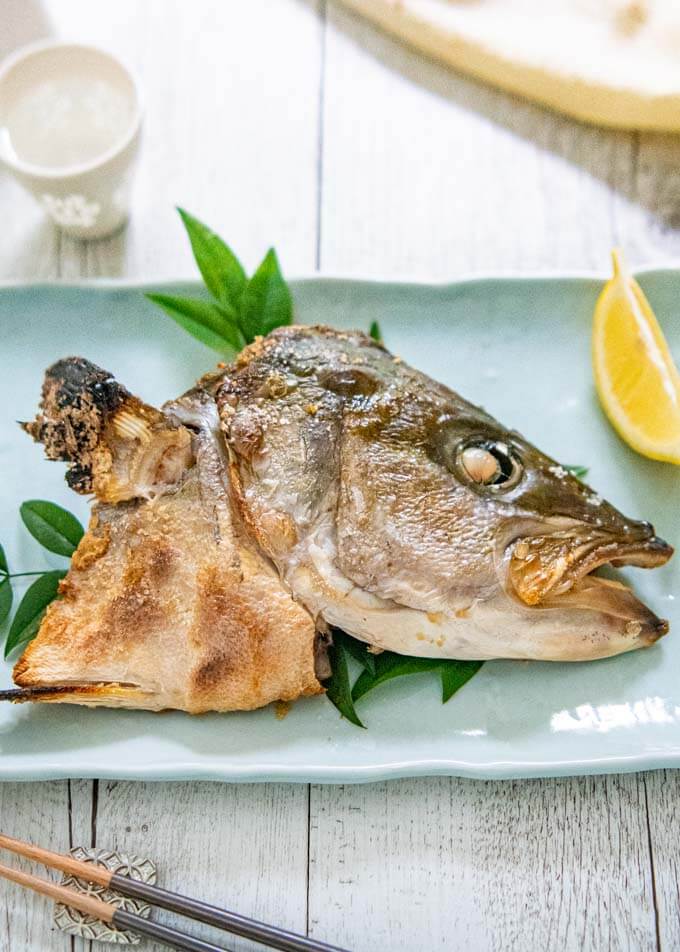
You will be surprised to know that the head of a fish contains quite a lot of meat. It depends on the size of the head, of course, but one side of the head is usually enough for one serving of protein. The meat I scraped off the grilled half head weighed 150g/5.3oz. I thought it was pretty good for $4 per half head.

You can see a large chunk of meat at the top of the head.
I have two different methods of grilling Kingfish head – shioyaki (grilled with salt) and tsukeyaki (grilled with sauce). Today’s recipe is Grilled Kingfish Head recipe using the shioyaki method, which is easier and faster than the tsukeyaki method. I will post the tsukeyaki recipe shortly.
About Kabutoyaki
Regardless of what kind of fish head you use, grilled fish head is called ‘kabutoyaki’ (兜焼き) in Japan. Kabuto (兜) is an ancient Japanese helmet worn by warriors. The word ‘yaki’ (焼き) means grilling.
The kanji character for kabuto, 兜, was formed by expressing a person (人 – bottom part of 兜) wearing a helmet (top part of 兜).
The name ‘kabutoyaki’ came from the similarity of the fish head to kabuto when the fish head is placed upright.
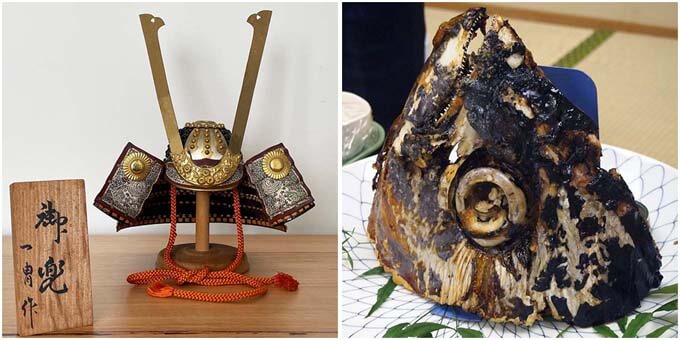
Left: Miniature kabuto. Right: tuna Kabutoyaki served at a restaurant in Yaizu, Shizuoka prefecture.
Kabutoyaki is usually made with a head (with or without the collar) of snapper, kingfish, or tuna. A fish head is usually halved vertically before grilling. However, the 2nd largest port city in Japan, Yaizu in Shizuoka prefecture, is famous for a whole head of grilled tuna that is served upright (see the photo above). This tuna kabutoyaki does not come with collars, but the sheer size of the tuna head contains quite a lot of meat without them.
What’s in My Grilled Kingfish Head (Kingfish Kabutoyaki)
Today’s kabutoyaki is the simplest grilled dish, requiring only a fish head and salt.
- A ½ head of kingfish with the collar
- Salt
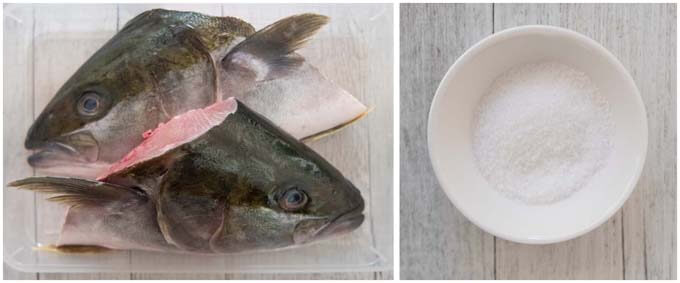
Although the photo above includes two halves of the head to show you the complete picture of the halved head, I used only one side of the head in the recipe.
My kingfish head came with the collar and weighed 1kg/2.2lb. I asked the fish shop to vertically halve the head. You can halve it using scissors and a cleaver, but it requires a bit of effort to do it.
The amount of salt you need is 2% of the weight of the fish head that you are grilling. It looks like quite a lot of salt, but you need to salt heavily for the salt to penetrate the salt into the flesh.
How to Make Grilled Kingfish Head (Kingfish Kabutoyaki)
Before sprinkling salt, you need to make sure the fish head, particularly the collar, is scale-free. If it came with gills along the collars, remove them.
- Heat the oven grill to 200°C/392°F.
- Rinse the head and collar, removing the scales if you find any, then pat-dry the head with paper towel.
- Sprinkle salt over the skin side and the cut side of the head. Put slightly more salt on the skin side.
- Place a rack on a tray lined with a sheet of aluminium foil and put the salted kingfish head on the rack, skin side down.
- Grill for about 8 minutes. Turn it over and grill for further 5 minutes.
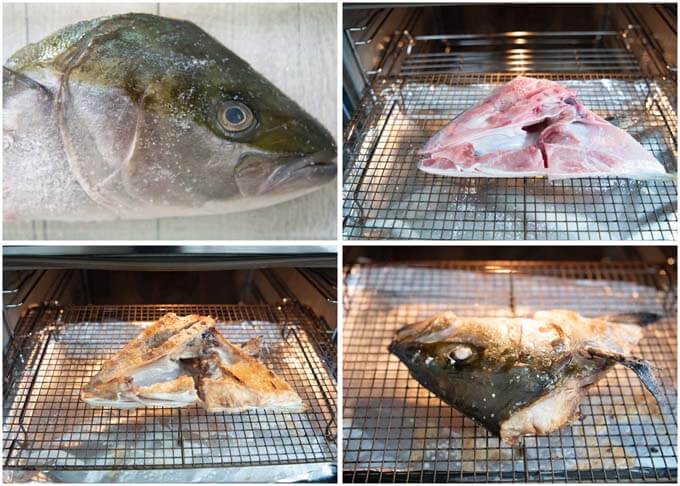
You need to show the skin side of Kabutoyaki when plating it. For this reason, grill the skin side later after turning it over. This will make the skin side crispy and nicely charred, which looks appetising.
The distance between the grill and the fish head is critical. It should be about 10cm/4″. If it is too close, the surface of the fish gets burnt before the flesh is cooked through.
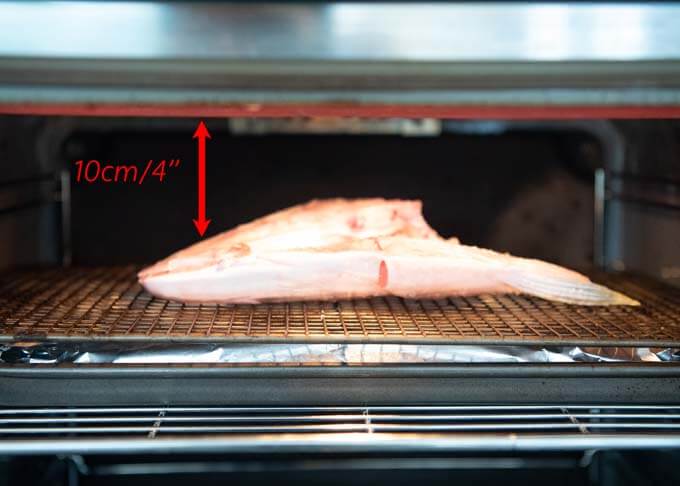
You can also grill the fish head over a BBQ or a grill pan.
Eating Grilled Kingfish Head
Unless you have eaten fish head before, it can be difficult to figure out where the delicious meat is. The photos below and the video show you where most meat is. It looks a bit messy (as eating fish head usually end up with a messy plate), but I hope you will get the idea of how to tackle it.
Collar
The easily recognisable portion of the edible part of a fish head is the collar. It is called ‘kama’ (カマ) in Japanese. Some fish shops sell just fish collars without a head intact. The flesh contains a good amount of fat, which makes it the delicious part of the fish meat.
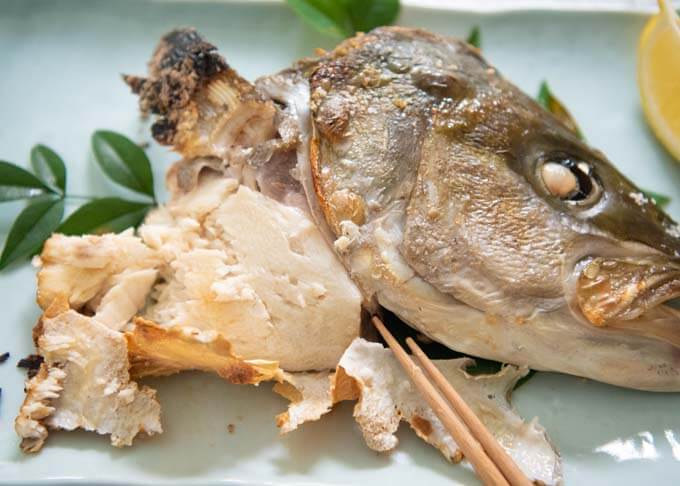
Top of Head
This is a hidden gem that some people might overlook. It makes the shape of the top part of the head and the meat starts from above the eye and ends at the back of the neck where the head is chopped off. It does not look like a lot of flesh is hidden under the skin, but you actually get a spear-shaped chunk of meat here.
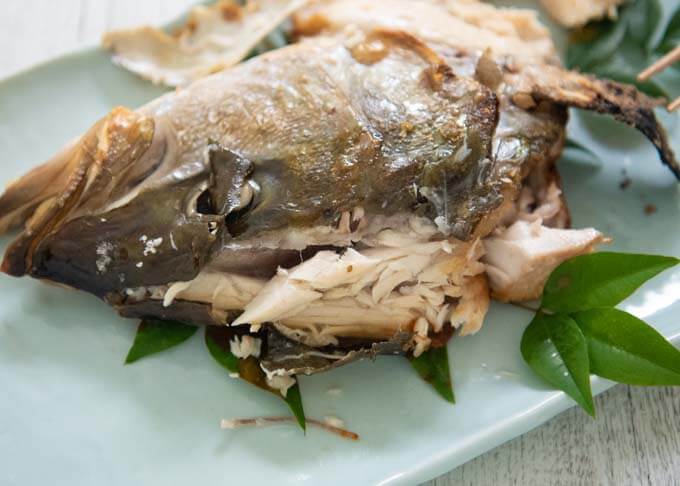
Cheek
The cheek meat is located just below the eye. It is surrounded by thin bones, but you will feel a soft section that contains a round scallop-shaped piece of meat. Just like beef cheek, fish cheek is delicious for the same reason, i.e., it’s close to the mouth and therefore the muscles are well used.

Around the Eye
It is not shown in the photo but there is a tiny amount of meat that contains collagen around the eye, which is also delicious.
Remaining Meat
After tackling the above obvious sections, look for small crevasses, underneath the skin, etc, and scrape all the meat off the fish head.
Skin
Grilled skin is delicious. Unlike salmon, kingfish skin can be tough but when it is grilled well, the skin becomes crispy. Eat the skin while hot so that you can enjoy crunchy salty skin chips.

Some Japanese restaurants serve Kabutoyaki. I know for a fact that many customers who order Kabutoyaki leave a lot of edible meat behind. It is really unfortunate that such a delicious dish is only half eaten. With the above descriptions and the video, I hope my readers will be able to eat up every part of Kabutoyaki.
Yumiko![]()
Watch How To Make It
This video is not to show you how to cook Kabutoyaki, but to show you how to eat Kingfish Kabutoyaki.

Grilled Kingfish Head (Kingfish Kabutoyaki) is a simple dish that uses only salt as a seasoning. You just sprinkle salt over the fish head and grill it. The flesh you get from the head and collar is so tasty and the cost of 1 head is pretty low considering the amount of meat you can get.
See the video that shows where to find delicious meat.
Don't forget to see the section 'MEAL IDEAS' below the recipe card! It gives you a list of dishes that I have already posted and this recipe that can make up a complete meal. I hope it is of help to you.
- ½ kingfish head (about 500g/1.1lb, note 1)
- 10g/0.4oz salt (note 2)
- A lemon wedge (optional)
-
Heat the oven grill to 200°C/392°F (note 3).
-
Rinse the head and collar, removing the scales if you find any. If the head came with gills along the collar, remove them.
-
Pat-dry the fish head with paper towels.
-
Sprinkle salt on both sides of the fish head, putting slightly more salt on the skin side.
-
Place a rack on a tray lined with aluminium foil, and put the fish head on the rack, cut side up (note 4).
-
Place the rack with the fish head under the grill. The distance between the heat and the fish head should be about 10cm/4”.
-
Cook for about 8 minutes, turn it over and cook for further 5 minutes (note 5). The surface of the skin should have charred patches.
-
Transfer the fish head to a serving plate, skin side up, with a lemon wedge if using.
-
Refer to the section in the post, Eating Grilled Kingfish Head and the video, to see where the delicious meats are.
1. I bought a whole head with collars, which weighed 1kg/2.2lb, and asked the fish shop to vertically halve the head.
2. This is 2% of the weight of ½ a head, which is just right for Kabutoyaki.
3. Instead of the oven grill, you can use a BBQ or grill pan.
4. Kabutoyaki is served showing the skin side up on the plate. This is the reason why I cook the cut side first so that the skin side gets nicely charred crispy patches on it.
5. If your fish head is smaller/larger, the time required to cook through the fish head will be less/more.
6. Nutrition per 100g/3.5oz of kingfish meat. Sodium is higher than actual intake since it is assumed that all the salt sprinkled over the fish was consumed.
serving: 102g calories: 146kcal fat: 5.2g (7%) saturated fat: 1.3g (7%) trans fat: 0.0g polyunsaturated fat: 1.4g monounsaturated fat: 2g cholesterol: 55mg (18%) sodium: 814mg (35%) carbohydrates: 0g (0%) dietary fibre: 0g (0%) sugar: 0g protein: 23g vitamin D: 0mcg (0%) calcium: 23mg (2%) iron: 0.5mg (3%) potassium: 420mg (9%)
Meal Ideas
A typical Japanese meal consists of a main dish, a couple of side dishes, a soup and rice. I try to come up with a combination of dishes with a variety of flavours, colours, textures and make-ahead dishes.
Since Grilled Kingfish Head is cooked with just salt, it goes with any side dishes. But you may want to pick one side dish with meat in it to add a little more protein. I picked Steamed Pumpkin with Beef Mince so that you can control the serving size to adjust the amount of meat you want.
Pumpkin adds a bright colour to the meal, but I also picked Vegetable Agebitashi to make the meal more colourful. Instead of Agebitashi, you can have a bowl of salad if you prefer.
- Main: Grilled Kingfish Head (Kingfish Kabutoyaki) – today’s recipe.
- Side dish 1: Steamed Pumpkin with Beef Mince Sauce (Pumpkin Soboro-an) – make ahead.
- Side dish 2: Fried Vegetables in Broth (Vegetables Agebitashi) – make ahead, or a fresh salad.
- Soup: Tofu and Wakame Miso Soup – or your favourite miso soup.
- Rice: Cooked Rice.
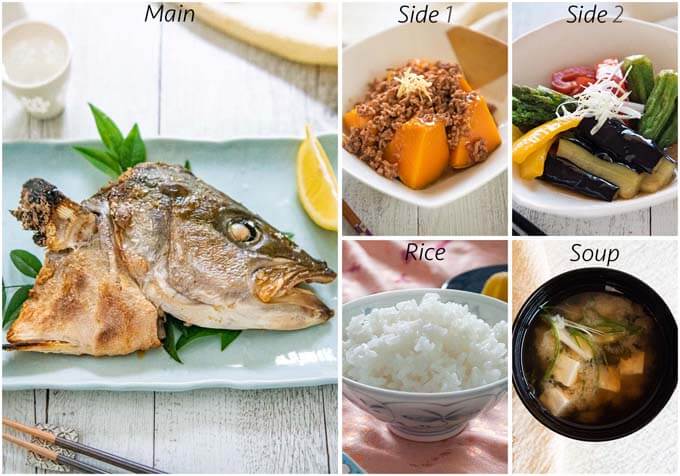
Hi Yumiko,
I love grilled fish heads. Sometimes in the past when I cooked kingfish head, the meat came out very mushy. So mushy it was offputting and inedible. I read that it’s due to a parasite that sometimes occurs in in the fish. Have you had this experience before?
Hi Goh, it is unfortunate that you had a bad experience with your grilled kingfish head. I have never had mushy meat. Could it be that your fish head was not very fresh either? The kingfish head I bought had gills attached along the collars, so I could check freshness of the head. It was an extra work to remove them before cooking the head, but it was worth the effort.